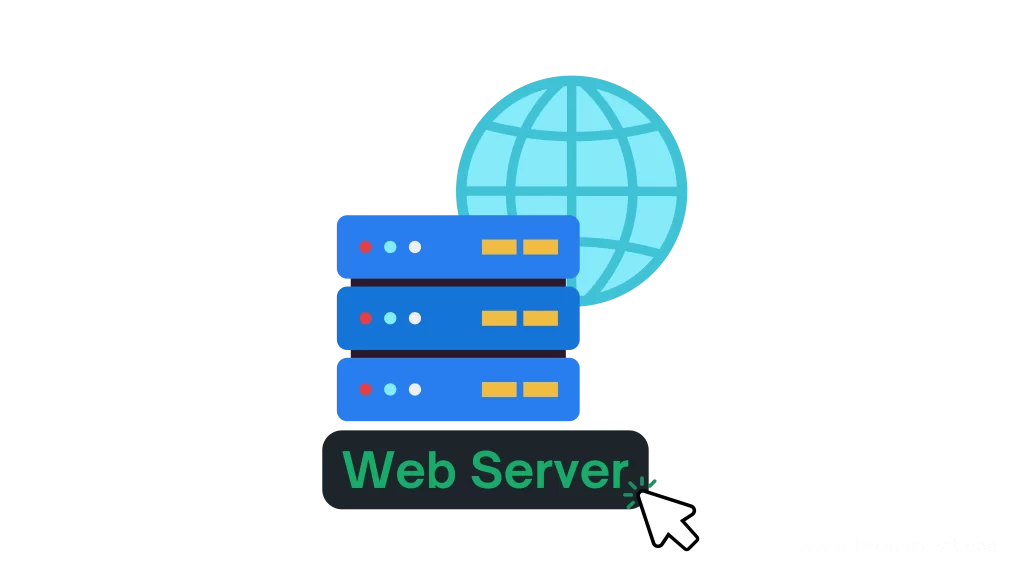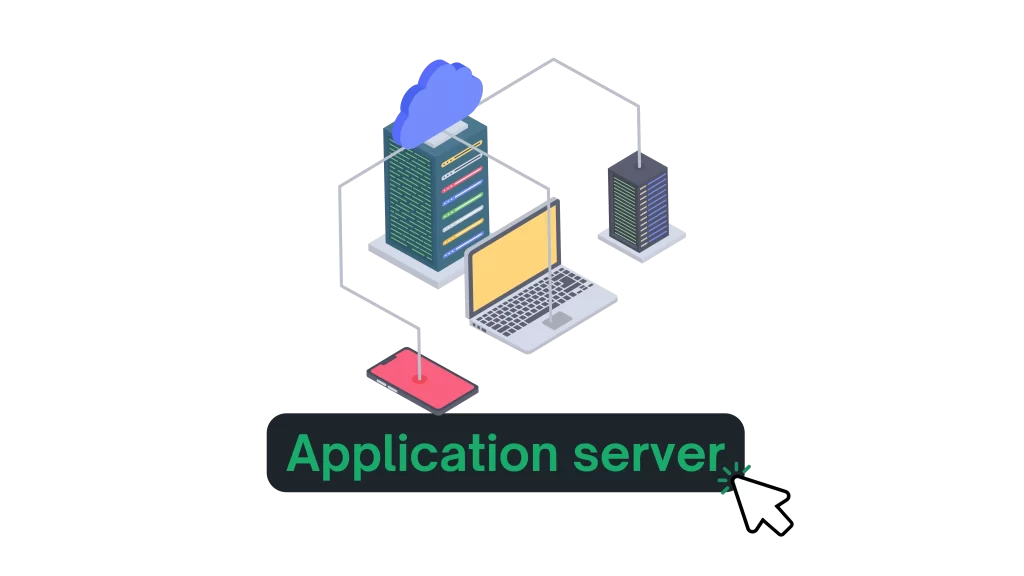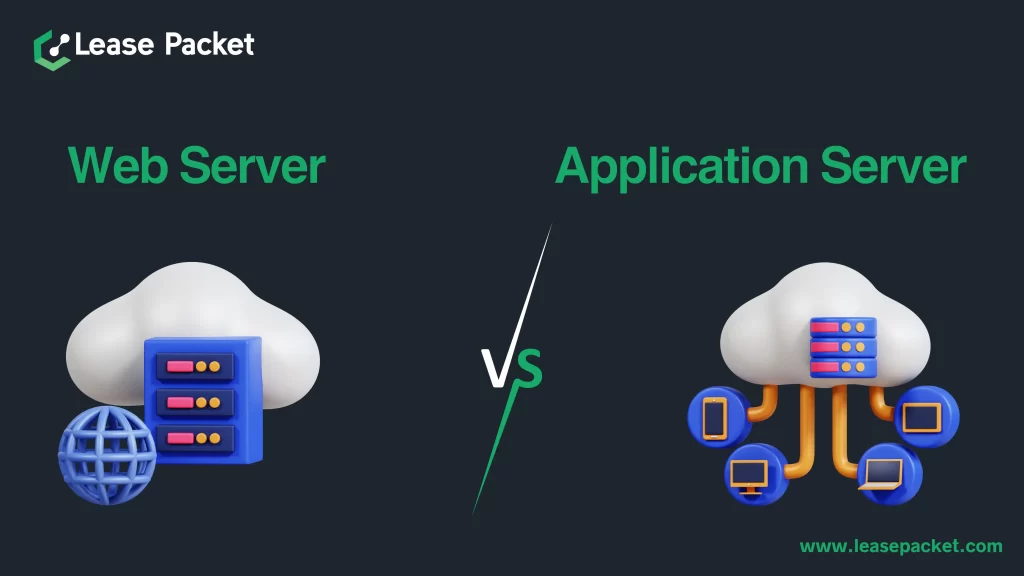In the world of web development and server management, two essential components play crucial roles in delivering web applications to users: the web server and the application server. While they may seem similar in function, they serve distinct purposes in the web ecosystem. In this blog post, we will explore the differences between these two servers, their roles, and how they work together to provide a seamless web experience. In this blog, we’re going to discuss the web server and application server and will do comparison of the web server vs application servers.

What is Web Server?
A web server is a software or hardware component that serves as the backbone of the World Wide Web, enabling the delivery of web content to clients, typically web browsers, over the internet. It plays a crucial role in handling incoming HTTP (Hypertext Transfer Protocol) requests from clients and responding with the appropriate content, which can include HTML files, images, stylesheets, JavaScript files, and more.
A web server is the first point of contact between a user’s web browser and a web application. Its primary function is to handle HTTP requests from clients (usually web browsers) and respond with the appropriate HTTP responses, often in the form of HTML pages, images, CSS, and JavaScript files.
Key Characteristics of a Web Server
Request Handling: Web servers are responsible for receiving incoming HTTP requests and processing them. They determine which files or resources to serve based on the requested URL and file paths.
Static Content Delivery: Web servers excel at delivering static content, such as HTML, images, stylesheets, and client-side scripts, directly to clients. These resources are typically stored on the server’s file system.
Efficiency: Web servers are optimized for handling a large number of concurrent connections and are designed to be lightweight and fast, making them ideal for serving static content efficiently.
Popular Web Servers
- Apache HTTP Server: The Apache HTTP Server, often simply referred to as Apache, is one of the most widely used open-source web servers globally. It was initially released in 1995 and has a long history of development and community support.
- Nginx: Nginx (pronounced “engine x”) is known for its high performance and efficient handling of concurrent connections. It was initially released in 2004 and has gained significant popularity in recent years.
- Microsoft Internet Information Services (IIS): IIS is Microsoft’s web server solution, designed primarily for Windows environments. It has been a part of Windows Server operating systems since Windows NT 3.51.

What is an Application Server?
An Application Server is a software framework or platform that provides the necessary environment and services for running and managing web applications. It serves as the backend component of a web application architecture and is responsible for executing server-side code, processing client requests, managing resources, and interacting with databases and other backend services.
Unlike web servers, application servers are responsible for handling dynamic content generation and business logic processing. They play a vital role in executing server-side code, such as scripts written in Python, Ruby, Java, or other programming languages, to generate dynamic web content in response to client requests.
Key Characteristics of an Application Server:
Dynamic Content Generation: Application servers process requests that involve database queries, authentication, session management, and other server-side tasks. They generate dynamic content, such as user-specific web pages, by executing code in response to client requests.
Business Logic: Application servers often contain the core business logic of a web application. They manage application-specific functionality and interact with databases and other backend services.
Integration: Application servers can integrate with databases, message queues, and other services to provide a complete backend infrastructure for web applications.
Popular Application Servers:
- Tomcat (for Java applications): Apache Tomcat, often referred to as Tomcat, is an open-source web server and servlet container designed for executing Java-based web applications. It implements the Java Servlet, JavaServer Pages (JSP), and WebSocket specifications.
- Ruby on Rails (for Ruby applications): Ruby on Rails, often referred to as Rails, is a popular open-source web framework for building web applications using the Ruby programming language. Rails follows the Model-View-Controller (MVC) architectural pattern.
- Django (for Python applications): Django is a high-level open-source Python web framework that follows the “batteries-included” philosophy, providing a comprehensive set of tools and libraries for web development.
- Node.js (for JavaScript applications): Node.js is an open-source runtime environment that allows developers to run JavaScript on the server side. It’s built on Chrome’s V8 JavaScript engine and is known for its non-blocking, event-driven architecture.
Web Server and Application Server Collaboration
To create a complete web application infrastructure, web servers, and application servers often work together. This collaboration is achieved using a common deployment pattern known as the “reverse proxy” or “reverse proxy server.” In this setup, the web server handles incoming client requests and forwards them to the application server for processing. The application server generates the necessary dynamic content and returns it to the web server, which, in turn, sends it back to the client.
Benefits of Web Server and Application Server Collaboration
Load Balancing: Web servers can distribute client requests among multiple application server instances, ensuring optimal performance and fault tolerance.
Security: Web servers can act as a buffer between clients and application servers, adding an extra layer of security by hiding the internal structure of the application.
Caching: Web servers can cache static content, reducing the load on application servers and improving overall response times.
What is the difference between web server and application server (Web Server vs Application Server)

The difference between web server and application server lies in their roles, responsibilities, and the types of tasks they handle in the context of web application development. Let’s explore these What is difference between web server and application server with the below given points:
Web Server:
Responsibility: A web server primarily handles HTTP requests and responses. It focuses on managing the communication between clients (usually web browsers) and the web application.
Static Content: Web servers are excellent at serving static content, such as HTML files, images, stylesheets, and client-side scripts. They send these files directly to clients without any server-side processing.
Request Routing: Web servers route incoming HTTP requests to the appropriate resources based on the requested URLs, file paths, or configurations. This often involves URL rewriting and redirection.
Efficiency: Web servers are optimized for efficiently serving a large number of concurrent connections. They are designed to be lightweight and fast, emphasizing the rapid delivery of static content.
Load Balancing: Web servers can be used in conjunction with load balancers to distribute incoming requests among multiple server instances, improving performance and fault tolerance.
Security: Web servers often provide security features like SSL/TLS encryption, IP blocking, and request filtering. They can also act as a buffer between clients and application servers, adding a layer of security.
Application Server:
Responsibility: An application server handles the execution of server-side code, processing client requests, managing application-specific logic, and interacting with databases and other backend services.
Dynamic Content: Application servers are responsible for generating dynamic content in response to client requests. This includes executing server-side code, querying databases, and creating customized responses.
Business Logic: Application servers contain the core business logic of a web application. They manage application-specific functionality, handle user authentication, and enforce access control.
Database Interaction: Application servers interact with databases to retrieve and update data. They use database connectors or ORM frameworks to facilitate these interactions.
Session Management: Application servers often manage user sessions to maintain state between requests, typically using cookies or other mechanisms.
Resource Management: Application servers handle system resources, such as memory and CPU, to ensure the efficient execution of server-side code. They may also manage resource pooling and reuse.
Security: Application servers provide security features like authentication, authorization, and input validation to protect against common web vulnerabilities.
Web Server vs Application Server
The below given table represents the distinct roles and responsibilities of web servers and application servers in the context of web application development. While they are both integral components of a web application stack, they serve different purposes and work together to deliver a complete web experience to users. Here is the list of what is difference between a web server and application server:
| Aspect | Web Server | Application Server |
|---|---|---|
| Responsibility | Handles HTTP requests and responses | Executes server-side code and manages application-specific logic. |
| Static Content | Efficiently serves static content (HTML, images, CSS, etc.). | Focuses on generating dynamic content. |
| Dynamic Content | Does not generate dynamic content; it serves pre-existing resources. | Generates dynamic content through server-side code execution. |
| Business Logic | Not responsible for application-specific business logic. | Manages application-specific functionality and business rules. |
| Database Interaction | Typically does not directly interact with databases | Interacts with databases to retrieve and update data. |
| Session Management | Usually does not manage user sessions. | Often manages user sessions to maintain state between requests. |
| Resource Management | Optimized for efficiently serving static content. | Handles system resources (e.g., memory) for server-side code execution |
| Security | May provide security features like SSL/TLS, IP blocking, and request filtering. | Offers security features such as authentication, authorization, and input validation. |
Conclusion
In summary, the application server and web server are fundamental components of web application architecture. While web servers excel at serving static content efficiently, application servers are responsible for dynamic content generation and business logic processing. Together, they create a robust infrastructure for delivering web applications reliably and efficiently to users. Understanding the roles and interactions between these servers is essential for building and maintaining modern web applications.
Web servers and application servers have distinct roles in the web application architecture. Web servers are responsible for handling client requests, routing them to the appropriate resources, and efficiently serving static content. Application servers, on the other hand, focus on executing server-side code, processing dynamic requests, and managing the core business logic of the application. In many web applications, these two types of servers work together to deliver a complete and efficient web experience to users.
FAQs
Q. 1 What is the primary function of a web server
A web server primarily handles HTTP requests from clients (usually web browsers) and responds by serving static content like HTML pages, images, and CSS files.
Q. 2 What does an Application Server do?
An application server executes server-side code, manages application-specific logic, and interacts with databases, and generates dynamic content in response to client requests.
Q. What are the differences between Web Server and Application Server?
Web servers focus on serving static content and routing requests, while Application Servers handle dynamic content generation, business logic, and database interactions.
Q. 4 Do web servers and Application Servers work together?
Yes, in many web applications, web servers and application servers collaborate. Web servers often act as a reverse proxy, forwarding dynamic requests to application servers for processing.
Q. 5 Where can I the best servers for my business?
To get the best server provider, you need to do deep research about the providers. You should also be aware of which kind of server you need for your business. If you’re in search of a reliable and affordable server provider, then the Lease packet data center is the best to help you and your business.

























